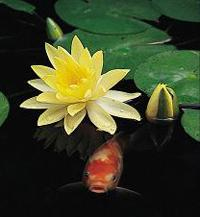watergarden
Most people know that an ecosystem is, by definition, an ecological community that, together with its environment, functions as a unit. Fewer probably know that the word ecology comes from two Greek words: oilcos, meaning “house,” and logos, meaning “the study of.” Together, the word literally means “study of the home.” The result is a word packed with meaning and power, both emotional and practical. Its implications reach everywhere, even into the realm of watershaping and especially
Successful residential exterior design is akin to a precisely choreographed dance. One sequence of steps defines the relationships among hardscape, water and plants. Other sequences distinguish light and shadow, color and texture, open views and intimate spaces. If the choreographer has done a good job, we don't see the individual steps so much as we enjoy the overall experience of motion. The key to making these multifarious steps work together? It's all about balance. Transferring these principles to backyard design, there's a similar need for
The combination of water and plant material is so pervasive and obvious in natural and man-made settings that it's easy to take it for granted. In urban parks, rural settings and countless backyards, where one finds the blue, one also finds the green - and we all seem pre-wired
To know where you're going, you need to have a sense of where you've been. That phrase is a bit shopworn, but it
It's a tale of two professions: Pool and spa people are taught to keep things dead; pond people are taught to keep things alive. Pool people sell chlorine; pond people sell de-chlorinator. Pool people sterilize; pond people fertilize. This contrast in approaches to basic water maintenance is perhaps the most significant difference between two trades that are coming into closer and closer contact with one another every day. At issue between the two groups is whether to work against nature in a sterile system, or work with it to create an ecosystem. Each discipline has a foundation in the science of water chemistry and both have a place in the world - but beyond that (and as the table below demonstrates), things really couldn't be much different. As more and more pool/spa professionals move into water gardening and more and more landscape designers and architects get into pools and spas, there's an increasing need for all of us to understand these water-treatment distinctions and the basics of each approach. I come from the pond side, so I'll cover things from that perspective in a pair of articles - a science-oriented overview this time before we
This past January, I had the pleasure of traveling to Tucson, Ariz., to attend the annual conference of the Association of Professional Landscape Designers. The focus of this year's conference was the use of water in landscape design, and the program appropriately featured an interesting mix of experts on swimming pools, fountains and water gardening. To be honest, I didn't know what to expect when I signed on. I'd only been to one landscape event before, and much of that trade and the people in it have been mostly unfamiliar to me. As it turned out, however, this conference was

















